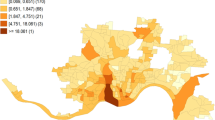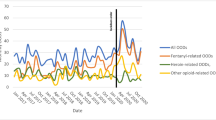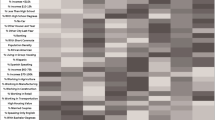Abstract
We investigate the geographic patterns of drug poisoning deaths involving heroin by county for the USA from 2000 to 2014. The county-level patterns of mortality are examined with respect to age-adjusted rates of death for different classes of urbanization and racial and ethnic groups, while rates based on raw counts of drug poisoning deaths involving heroin are estimated for different age groups and by gender. To account for possible underestimations in these rates due to small areas or small numbers, spatial empirical Baye’s estimation techniques have been used to smooth the rates of death and alleviate underestimation when analyzing spatial patterns for these different groups. The geographic pattern of poisoning deaths involving heroin has shifted from the west coast of the USA in the year 2000 to New England, the Mid-Atlantic region, and the Great Lakes and central Ohio Valley by 2014. The evolution over space and time of clusters of drug poisoning deaths involving heroin is confirmed through the SaTScan analysis. For this period, White males were found to be the most impacted population group overall; however, Blacks and Hispanics are highly impacted in counties where significant populations of these two groups reside. Our results show that while 35–54-year-olds were the most highly impacted age group by county from 2000 to 2010, by 2014, the trend had changed with an increasing number of counties experiencing higher death rates for individuals 25–34 years. The percentage of counties across the USA classified as large metro with deaths involving heroin is estimated to have decreased from approximately 73% in 2010 to just fewer than 56% in 2014, with a shift to small metro and non-metro counties. Understanding the geographic variations in impact on different population groups in the USA has become particularly necessary in light of the extreme increase in the use and misuse of street drugs including heroin and the subsequent rise in opioid-related deaths in the USA.





Similar content being viewed by others
References
Substance Abuse and Mental Health Services Administration. Results from the 2011 National Survey on Drug Use and Health: Summary of National Findings, NSDUH Series H-48, HHS Publication No. (SMA) 14-4863. Rockville. 2012.
Substance Abuse and Mental Health Services Administration. Results from the 2014 National Survey on Drug Use and Health: Summary of National Findings, NSDUH Series H-48, HHS Publication No. (SMA) 14-4863. Rockville. 2015.
Ford M, Dulaney AR. Prescription drug overdose: data from Carolinas Poison Center. N C Med J. 2014;74(3):74316. http://www.cdc.gov/psr/prescriptiondrug/. Accessed Aug 2016
Mars SG, Bourgois P, Karandinos G, Montero F, Ciccarone D. “Every ‘never’ I Ever Said Came True”: transitions from opioid pills to heroin injecting. Int J Drug Policy. 2014;25(2):257–66. doi:10.1016/j.drugpo.2013.10.004.
Coplan PM, Kale H, Sandstrom L, Landau C, Chilcoat HD. Changes in oxycodone and heroin exposures in the National Poison Data System after introduction of extended-release oxycodone with abuse-deterrent characteristics. Pharmacoepidemiol Drug Saf. 2013;22:1274–82. doi:10.1002/pds.3522.
Dertadian GC, Maher L. From oxycodone to heroin: two cases of transitioning opioid use in young Australians. Drug Alcohol Rev. 2014;33(1):102–4. doi:10.1111/dar.12093.
Rossen LM, Khan D, Warner M. Trends and geographic patterns in drug-poisoning death rates in the U.S., 1999–2009. Am J Prev Med. 2013;45(6):e19–25. doi:10.1016/j.amepre.2013.07.012.
Rossen LM, Khan D, Warner M. Hot spots in mortality from drug poisoning in the United States, 2007-2009. Heal Place. 2014;26:14–20. doi:10.1016/j.healthplace.2013.11.005.
Darke S, Marel C, Mills KL, et al. Patterns and correlates of non-fatal heroin overdose at 11-year follow-up: findings from the Australian Treatment Outcome Study. Drug Alcohol Depend. 2014;144:148–52. doi:10.1016/j.drugalcdep.2014.09.001.
Strang J. Death matters: understanding heroin/opiate overdose risk and testing potential to prevent deaths. Addiction. 2015;110:27–35. doi:10.1111/add.12904.
Mateu-Gelabert P, Harris S, Berbesi D, et al. Heroin use and injection risk behaviors in Colombia: implications for HIV/AIDS prevention. Subst Use Misuse. 2016;51(2):230–40. doi:10.3109/10826084.2015.1092989.
Cedarbaum ER, Banta-green CJ. Health behaviors of young adult heroin injectors in the Seattle area. Drug Alcohol Depend. 2016;158:102–9. doi:10.1016/j.drugalcdep.2015.11.011.
Peavy KM, Banta-Green CJ, Kingston S, Hanrahan M, Merrill JO, Coffin PO. “Hooked on” prescription-type opiates prior to using heroin: results from a survey of syringe exchange clients. J Psychoactive Drugs. 2012;44(3):259–65. doi:10.1080/02791072.2012.704591.
Jenkins LM, Banta-Green CJ, Maynard C, et al. Risk factors for nonfatal overdose at seattle-area syringe exchanges. J Urban Heal. 2011;88(1):118–28. doi:10.1007/s11524-010-9525-6.
Dasgupta N, Creppage K, Austin A, Ringwalt C, Sanford C, Proescholdbell SK. Observed transition from opioid analgesic deaths toward heroin. Drug Alcohol Depend. 2014;145:238–41. doi:10.1016/j.drugalcdep.2014.10.005.
Martins SS, Santaella-Tenorio J, Marshall BDL, Maldonado A, Cerdá M. Racial/ethnic differences in trends in heroin use and heroin-related risk behaviors among nonmedical prescription opioid users. Drug Alcohol Depend. 2015;151:278–83. doi:10.1016/j.drugalcdep.2015.03.020.
Visconti AJ, Santos G-M, Lemos NP, Burke C, Coffin PO. Opioid overdose deaths in the city and county of San Francisco: prevalence, distribution, and disparities. J Urban Health. 2015;92(4):758–72. doi:10.1007/s11524-015-9967-y.
Rigg KK, Monnat SM. Urban vs. rural differences in prescription opioid misuse among adults in the United States: informing region specific drug policies and interventions. Int J Drug Policy. 2015;26(5):484–91. doi:10.1016/j.drugpo.2014.10.001.
Day C, Conroy E, Lowe J, Page J, Dolan K. Original article patterns of drug use and associated harms among rural injecting drug users: comparisons with metropolitan injecting drug users. Aust J Rural Health. 2006;14:120–5. doi:10.1111/j.1440-1584.2006.00775.x.
Wenger LD, Lopez AM, Comfort M, Kral AH. The phenomenon of low-frequency heroin injection among street-based urban poor: drug user strategies and contexts of use. Int J Drug Policy. 2014;25(3):471–9. doi:10.1016/j.drugpo.2014.02.015.
Meiman J, Tomasallo C, Paulozzi L. Trends and characteristics of heroin overdoses in Wisconsin, 2003-2012. Drug Alcohol Depend. 2015;152:177–84. doi:10.1016/j.drugalcdep.2015.04.002.
Cicero TJ, Ellis MS, Surratt HL, Kurtz SP. The changing face of heroin use in the United States: a retrospective analysis of the past 50 years. JAMA psychiatry. 2014;71(7):821–6. doi:10.1001/jamapsychiatry.2014.366.
Cicero TJ, Surratt H, Inciardi JA, Munoz A. Relationship between therapeutic use and abuse of opioid analgesics in rural, suburban, and urban locations in the United States. Pharmacoepidemiol Drug Safety2. 2007;16:827–40. doi:10.1002/pds.1452.
Rudd RA, Seth P, David F, Scholl L. Increases in drug and opioid-involved overdose deaths—United States, 2010-2015. Morb Mortal Wkly Rep. 2016;65:1445–52. doi:10.15585/mmwr.mm655051e1.
Kao D, Torres LR, Guerrero EG, Mauldin RL, Bordnick PS. Spatial accessibility of drug treatment facilities and the effects on locus of control, drug use, and service use among heroin-injecting Mexican American men. Int J Drug Policy. 2014;25(3):598–607. doi:10.1016/j.drugpo.2013.12.012.
Beardsley K, Wish ED, Fitzelle DB, O’Grady K, Arria AM. Distance traveled to outpatient drug treatment and client retention. J Subst Abus Treat. 2003;25(4):279–85. doi:10.1016/S0740-5472(03)00188-0.
Hester L, Shi X, Morden N. Characterizing the geographic variation and risk factors of fatal prescription opioid poisoning in New Hampshire, 2003-2007. Ann GIS. 2012;18(2):99–108. doi:10.1080/19475683.2012.668558.
Moran PA. The interpretation of statistical maps. J R Statisitcal Soc Ser B. 1948;10(2):243–51.
Anselin L. Local indicators of spatial association: LISA. Geogr Anal. 1995;27(2):93–115.
Kulldorff M. A spatial scan statistic. Commun Stat - Theory Methods. 1997;26(6):1481–96. doi:10.1080/03610929708831995.
Kulldorff M, Heffernan R, Hartman J, Assuncao R, Mostashari F. A space-time permutation scan statistic for disease outbreak detection. PLoS Med. 2005;2(3):0216–24. doi:10.1371/journal.pmed.0020059.
Chen J, Roth RE, Naito AT, Lengerich EJ, Maceachren AM. Geovisual analytics to enhance spatial scan statistic interpretation: an analysis of U.S. cervical cancer mortality. Int J Health Geogr. 2008;7:57. doi:10.1186/1476-072X-7-57.
Barro AS, Kracalik IT, Malania L, Tsertsvadze N, Manvelyan J, Imnadze P, et al. Identifying hotspots of human anthrax transmission using three local clusering techniques. Appl Geogr. 2015;60:29–36. doi:10.1016/j.apgeog.2015.02.014.
Shah NG, Lathrop SL, Reichard RR, Landen MG. Unintentional drug overdose death trends in New Mexico, USA, 1990-2005: combinations of heroin, cocaine, prescription opioids and alcohol. Addiction. 2008;103(1):126–36. doi:10.1111/j.1360-0443.2007.02054.x.
Banta-Green C, Jackson TR, Freng S, et al. Drug abuse trends in the Seattle-King County area: 2014. Alcohol & Drug Abuse Institute, Univ. of Washington, June 17, 2015. adai.uw.edu/pubs/cewg/DrugTrends_2014_final.pdf. Accessed Aug 2016.
Pollini RA, Banta-Green CJ, Cuevas-Mota J, Metzner M, Teshale E, Garfein RS. Problematic use of prescription-type opioids prior to heroin use among young heroin injectors. Subst Abuse Rehabil. 2011;2(1):173–80. doi:10.2147/SAR.S24800.
Walley AY, Xuan Z, Hackman HH, et al. Opioid overdose rates and implementation of overdose education and nasal naloxone distribution in Massachusetts: interrupted time series analysis. BMJ. 2013;346(January):f174. doi:10.1136/bmj.f174.
Acknowledgments
Research reported in this publication was supported by the NIDA-funded National Drug Early Warning System (NDEWS). NDEWS is supported by the National Institute on Drug Abuse of the National Institutes of Health, under Cooperative Agreement U01DA038360, awarded to the Center for Substance Abuse Research (CESAR) at the University of Maryland, College Park. The content is solely the responsibility of the authors and does not necessarily represent the official views of the National Institutes of Health.
Author information
Authors and Affiliations
Corresponding author
Rights and permissions
About this article
Cite this article
Stewart, K., Cao, Y., Hsu, M.H. et al. Geospatial Analysis of Drug Poisoning Deaths Involving Heroin in the USA, 2000–2014. J Urban Health 94, 572–586 (2017). https://doi.org/10.1007/s11524-017-0177-7
Published:
Issue Date:
DOI: https://doi.org/10.1007/s11524-017-0177-7




